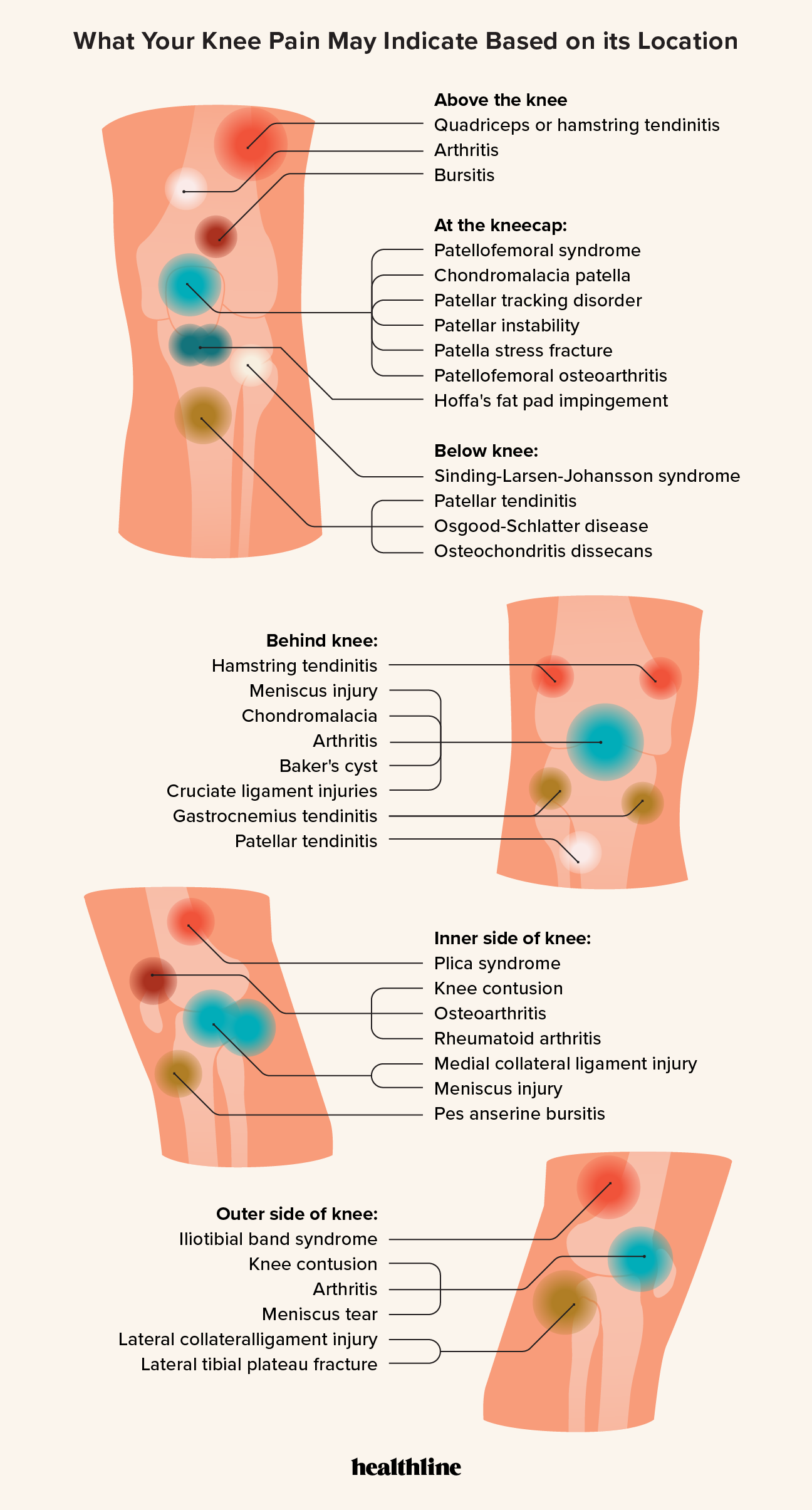Knee Pain Charts
Learn about possible causes of knee pain based on its location with this helpful knee pain chart. Includes information on common conditions like quadriceps tendonitis, patellofemoral arthritis, and more.
Pain at the front above the knee
Quadriceps tendonitis – this is caused by the irritation, strain or injury to the quadriceps tendon.
Patellofemoral Arthritis – this affects the underside of the kneecap (patella) and the trochlear groove in the femur in which it moves.
Plica Syndrome – a plica is the fold in the thin synovial membrane that lines the knee joint.
Lateral patellar facet overload syndrome – this refers to dull aching pain underneath, around the sides or below kneecap.
Synovitis – the knee is a synovial hinge joint, and as such the joint is lined with a synovial membrane.
Pain at the knee itself
Anterior Cruciate Ligament (ACL) – Damage occurs due to twisting, over extension or sudden force through the knee.
Patellofemoral pain syndrome – a general term used for a dull pain in the vicinity of the kneecap and front of the knee.
Patella Chondromalacia – caused by the softening and deterioration of the cartilage on the underside of the kneecap or a loose flap of cartilage.
Bursitis – if one of the thin, fluid-filled sacs at the points of contact between bone and soft tissue at the front of the knee become inflamed it causes swelling on the knee, tenderness and a dull ache.
Osteoarthritis – a painful condition which commonly affects the knee joint.
Lateral pain (outer side of the knee)
Hamstring Tendinitis – caused by inflammation of the tendon which attaches one of the muscles of the hamstring, the biceps femoris, to the back of the knee.
Iliotibial Band Syndrome – inflammation and irritation of the thick fibrous iliotibial band which runs from the pelvis to the tibia on the outside of the leg.
Bursitis – if one of the thin, fluid-filled sacs at the points of contact between bone and soft tissue at the front of the knee become inflamed it causes swelling on the knee, tenderness and a dull ache.
Osteoarthritis – if cartilage starts to wear down and degenerate, extra fluid may be produced and bony osteophytes form.
Lateral meniscus tear – the menisci are crescent-shaped bands of cartilage which act as shock absorbers for the knee.
Medial pain (inner side of the knee)
Medial meniscus tear or loose cartilage – if the meniscus on the inner side of the knee becomes torn or a small piece of cartilage becomes detached or loose, it will cause pain, swelling and mobility problems.
Osteoarthritis – if the cartilage of the medial femorotibial compartment begins to wear down and degenerate, the production of extra synovial fluid and formation of bony osteophytes cause pain, reduced mobility and instability.
Medial Collateral Ligament damage – the medial collateral ligament is one of the four ligaments which aid stability of the knee joint.
Irritation of medial plica – if a plica becomes inflamed because of injury or overuse it can cause pain, swelling or locking of the knee joint.
Osteochondral defect – damage and loss of some articular cartilage which affects the underlying bone.
Pain at the back of the knee
Hamstring tendonitis – if the tendon becomes inflamed because of overuse a sharp pain is felt at the back of the knee.
Popliteus muscle injury – exercise or trauma may cause injury to the popliteus muscle.
Posterior cruciate ligament injury – when injuries occur to this ligament it is usually when the knee is bent.
Baker’s cyst – an excessive accumulation of synovial fluid in an inflamed bursa of the popliteal fossa, caused by arthritis or trauma, and the swelling is seen behind the knee causing a feeling of tightness.
Meniscus tear or loose cartilage – stiffness and pain at the back of the knee may be due to a torn posterior horn of one of the menisci.

What Your Knee Pain May Indicate Based on Its Location
| Knee Pain Location | Possible Causes of Pain |
|---|---|
| Front above the knee | Quadriceps tendonitis Patellofemoral Arthritis Plica Syndrome Lateral patellar facet overload syndrome Synovitis |
| Knee itself | Anterior Cruciate Ligament (ACL) Patellofemoral pain syndrome Patella Chondromalacia Patellofemoral Arthritis Partially dislocated patella Patella tendonitis Osgood-Schlatter Disease Sinding-Larsen-Johansson syndrome Bursitis Osteoarthritis Bone tumours Inflammatory joint disease |
| Lateral pain (outer side of the knee) | Hamstring Tendinitis Iliotibial Band Syndrome Lateral collateral ligament damage Lateral meniscus tear Cyst forming pressure on the meniscus Osteoarthritis Dislocation of the superior tibiofibular joint and possible accompanying peroneal nerve damage Tibial plateau fracture Posterolateral corner injury (PLC) |
| Medial pain (inner side of the knee) | Irritation of medial plica Medial meniscus tear or loose cartilage Osteoarthritis Medial Collateral Ligament damage Osteochondral defect Avascular necrosis |
| Back of the knee | Hamstring tendonitis Hamstring tear or pull Popliteus muscle injury Cramp Posterior cruciate ligament injury Baker’s cyst Meniscus tear or loose cartilage |

